18.10.2004
M.Dvoretsky. Positional sacrifice of the Queen (continuation)
(Read the beginning of the article)
In all the before analyzed examples a sacrifice of Queen was undertaken during defense of a difficult position, its purpose was changing of the character of struggle, creation of counter-play. Certainly, other situations also occur, when Queen is sacrificed in order to attack the King.
Nezhmetdinov – Chernikov B35
Team championship of the Russian Soviet Federative Socialist Republic 1962
1.e2-e4 c7-c5
2.¤g1-f3 ¤b8-c6
3.d2-d4 c5:d4
4.¤f3:d4 g7-g6
5.¤b1-c3 ¥f8-g7
6.¥c1-e3 ¤g8-f6
7.¥f1-c4 0-0
8.¥c4-b3 ¤f6-g4?!
9.£d1:g4 ¤c6:d4
10.Јg4-h4
According to the theory 10.Јd1 is simpler and stronger!, for example, 10...¤:b3 11.ab b6 12.Ґd4 with advantage of White.
10. . . . Јd8-a5
10...d6 11.0-0 Ґe6 can also be found.
11.0-0 Ґg7-f6
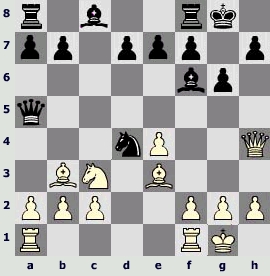
What White is to do? 12.Јg3? is not correct as 12...Ј:c3!, and 12.Јh6 Ґg7 13.Јh4 [13.Јg5 Ј:g5 14.Ґ:g5 ¤:b3 15.ab Ґ:c3 16.bc f6=] 13...Ґf6 leads to repetition of moves. In the 6th game of the match Fischer – Reshevsky (New York/Los Angeles 1961) was played 12.Јg4 d6 13.Јd1 ¤c6 with approximately equal chances (indeed, it`s more logical to move the Queen straight away at d1 than to move it back there from h4).
White has however one more risky possibility, which was used for the first time by Rashid Nezhmetdinov in this game: a sacrifice of the Queen for two light pieces!
12.£h4:f6! ¤d4-e2+!
Certainly not 12...¤:b3? 13.ab! £:a1 14.£:e7 £a5 15.¥h6 £d8 16.¤d5!ќ.
13.¤c3:e2 e7:f6
14.¤e2-c3
If Black took the Queen right away: 12...ef?!, then after 13.Ґ:d4 would appear the same position, but with white Bishop at the more active square d4. Thus, the distracting check by the Knight allowed Black to win an important tempo.
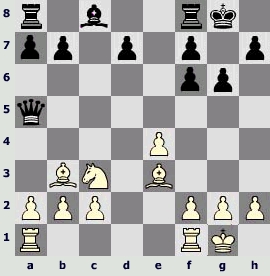
Objectively White has no advantage. An exact defense is expected from Black though (at the moment – from the danger of ¤d5 and Ґd4). Standard estimations don`t work here and it`s not easy to understand, in what particular way he should struggle against the opponent`s attack. In particular, should he sacrifice a pawn by the move 14...d5 in order to quicken the development!?
This way it was played it was played a year later in the game Petsch – Medler (championship of GDR 1963). After 15.¤:d5 Ґe6 [ 15...¦d8 16.Ґd4 ¦:d5 17.ed ўg7 18.¦ae1 is worse with dangerous pressure (Chervinsky – Grabchevsky, championship of Poland 1963)] 16.¤:f6+ ўg7 17.Ґd4 ўh6 White can either force the repetition of moves (18.Ґe3+ ўg7 19.Ґd4 ўh6), or continue the struggle, moving forward pawns of the King side (in this game 18.h4 was next) or shifting the Rook to the 3rd rank.
By the way, Nezhmetdinov planned another method of attack:: 15.Ґd4!? (instead of 15.¤:d5).
14. . . . ¦f8-e8
15.¤c3-d5 ¦e8-e6
16.¥e3-d4 ¢g8-g7
17.¦a1-d1 d7-d6
17...b5!? deservedattention. It makes no sense for White to attack the opponent`s Queen in response: 18.Ґc3?! Јd8, as 19.¤:f6? b4! doesn`t work[19...¦:f6? 20.¦d6ќ] 20.¤h5+ [20.¤e8+ ўf8 21.Ґ:e6 bc 22.Ґd5 Ґa6°] 20...ўh6 21.Ґ:e6 bc 22.Ґd5 Ґa6°, and after 19.¦d3 there is also 19...b4! 20.¤:b4 a5 21.¤d5 ¥a6µ.
18.¦d3 should be played right away! It`s an interesting variant 18...¦:e4 19.Ґ:f6+ ўf8 20.Ґc3 b4!? [20...Јd8 21.¤f6 is dangerous with attack] 21.¤:b4 ¦:b4 22.a3 ¦:b3 23.Ґ:a5 ¦:b2 24.Ґb4+ ўg8 25.¦c1І – Black has worse, but probably a defensible ending.
18.¦d1-d3 Ґc8-d7
19.¦d3-f3 ¥d7-b5
To the difficult for Black position leads 19...¦e5 20.Ґc3! £c5 21.¤:f6 ¥e6 22.¥:e6 [22.¤d7!?] 22...fe 23.¦d1.
20.¥d4-c3 £a5-d8
21.¤d5:f6!
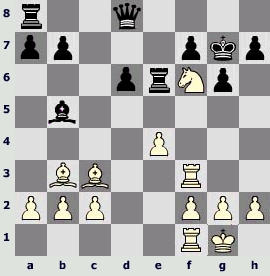
21. . . . ¥b5-e2?
It`s a crucial mistake! 21...Ґ:f1? 22.¤g4+ ўg8 23.Ґ:e6 was also losing. It was better to play 21...¦c8!, in order to either give the Rook for the menacing black-square Bishop or to neutralize the other Bishop by Ґc4 (in the variant 22.Ґd4 Ґc4 23.¤:h7+ ¦e5 24.¦d1 Јe7›).
Most likely, White would choose 22.Ґ:e6 ¦:c3! 23.bc. It`s not advantageous to move 23...Ґ:f1?! in response in view of 24.¤h5+ ўh6 [24...gh 25.¦:f7+ ўg6 26.ў:f1±] 25.¦:f7 Јg5 26.¤f4 with further g2-g3 and h2-h4 (not 26...Ґ:g2? 27.h4!ќ). After 23...fe 24.¦d1 White`s position is more preferable (24...Ґe2? 25.¦:d6 is bad), but nothing more.
It`s possible also 22.¤e8+ ўg8 [22...ўf8? 23.¤g7! ¦e7 24.¦:f7+ ¦:f7 25.¤e6+ ¢e7 26.¤:d8ќ] 23.¥:e6 fe 24.¤f6+. However after 24...ўg7 25.¦d1 ¦:c3! 26.bc the things narrowed down to the same position that would be in case of 22.Ґ:e6. In addition Black had the alternative: 24...ўh8 25.¤:h7+ [25.¦d1? ¦:c3 26.bc Ґe2 – this move works when he King is at h8; 25.¦e1 e5] 25...¦:c3 26.¦f8+ Ј:f8 27.¤:f8 ¦:c2 28.¦b1 Ґc4!?, and in the ending black pieces are quite active.
22.¤f6:h7+! ¢g7-g8
22...¢:h7 23.¦:f7+ ¢h6 24.¥:e6 ¥:f1 loses forcedly, and now either 25.¥d2+ g5 26.¥f5 £h8 [26...£g8 27.¦f6+ ¢h5 28.g4+ ¢h4 29.¦h6#] 27.h4!ќ, or 25.¥g7+ ¢h5 26.g4+ ¢h4 27.¢:f1ќ [27.¥f6+ £:f6 28.¦:f6ќ are also not bad].
23.¦f3-h3 ¦e6-e5
23...Ґ:f1 24.¤g5 ¦e5 25.¤:f7 is absolutely bad, but 23...¦c8!? was more stubborn. However after 24.¤g5 ¦:c3 25.¤:e6 fe 26.Ґ:e6+ ўg7 27.¦:c3 Ґ:f1 28.ў:f1 White`s advantage seems to be sufficient for win.
24.f2-f4! ¥e2:f1
25.ўg1:f1
Perhaps the move 25.¤g5!ќ would help to achieve the goal in less time.
25. . . . ¦a8-c8
26.¥c3-d4!?
White saves from exchange his menacing bishop. Even 26.fe de is sufficient for win [26...¦:c3 27.¤f6+] 27.¦d3 Јh4 28.Ґ:e5 Ј:h7 29.¦h3.
26. . . . b7-b5
27.¤h7-g5 ¦c8-c7
27...¦c4 28.Ґ:c4 bc 29.Ґ:e5 de 30.¦h8+! are not better.
28.Ґb3:f7+!
White finishes the struggle with simple, but elegant combination on the subject of Knight fork. He could also play 28.Ґ:e5 de 29.Ґ:f7+!.
28. . . . ¦c7:f7
29.¦h1-h8+! ¢g8:h8
30.¤g5:f7+ ¢h8-h7
31.¤f7:d8 ¦e5:e4
32.¤d8-c6 ¦e4:f4+
33.ўf1-e2
Black resigned.
Rashid Nezhmetdinov considered the following game to be the most beautiful of all his games. He managed to create a work of art, one of the best games in the history of chess. A positional sacrifice of the Queen for two light pieces was just an episode in this game; the possibility of it influenced the decision of Black at the 12th move. Another character had the brilliant sacrifice of the Queen for only one pawn at the 24th move: though it was impossible to estimate it completely, it can`t be called positional as Black hoped to checkmate the opponent.
Polugaevsky – Nezhmetdinov A53
Sochi 1958
(on basis of Nezhmetdinov`s comments)
1.d2-d4 ¤g8-f6
2.c2-c4 d7-d6
3.¤b1-c3 e7-e5
4.e2-e4?!
It`s not a very successful continuation (4.¤f3 or 4.dede 5.Ј:d8+ are stronger). By exchanging the central pawns Black ensnares the opponent`s Queen at d4 and then wins tempo by attacking the Queen by the Knight.
4. . . . e5:d4
5.£d1:d4 ¤b8-c6
6.£d4-d2 g7-g6
7.b2-b3 ¥f8-g7
8.Ґc1-b2 0-0
It`s interesting that the same position can be found in one of the variants of the English beginning: 1.c4 e5 2.¤c3 d6 3.d4!? ed 4.£:d4 ¤c6 5.£d2 ¤f6 6.e4?! [6.b3; 6.g3] 6...g6 7.b3 ¥g7 8.¥b2 0-0.
9.Ґf1-d3
9.f3!? deserved attention.
9. . . . ¤f6-g4!
10.¤g1-e2
For 10.0-0-0 Boleslavsky recommends 10...f5! 11.ef ¤b4 12.Ґe4 ¦:f5! 13.Ґ:f5 Ґ:f5 Black attacks.
If 10.¤f3, то 10...¤ge5!, and the exchange of Knights 11.¤:e5 de provides convenient play for Black because of having the central square d4. Andafter11.Ґe2 ¤:f3+ 12.Ґ:f3 ¤d4 13.Ґd1?! f5 the initiative is obviously on the side of Black, for example: 14.0-0 fe 15.¤:e4 d5! (Bagirov – Lukin, Tbilisi 1981).
Isaac Boleslavsky, having Black, effectively defeated Vladimir Alatortsev in this variant and was awarded the prize for the most beautiful game at the championship of USSR (Moscow 1950). The comments to the notation of that game were slightly specified by the winner:
14.ef ¥:f5 15.¤e2?White underestimates the danger. 15.0-0 is better, Black responded 15...c5. If 16.¤d5, then 16...Ґe6 [Boleslavsky suggested less exact 16...Ґe4because of response 17.Ґg4!, and in case of exchange at d5 white Bishop finds itself at е6] 17.¦e1 Ґ:d5 18.cd Јh4µ. 16.¤e2 d5 17.¤:d4 dcі is more reliable.
15...¤:e2 16.Ґ:e2.This move is also not the best one. However to16.Ґ:g7 Black had a strong response 16...¤f4!. For example, 17.Ґ:f8 Јf6! 18.f3 [18.ўf1 Јg5°] 18...¦e8+ 19.ўf2 ¤d3+ 20.ўg3 g5° with a terrible threat 21...Јe5+, or 17.Ј:f4 Јe7+ 18.Ґe2 [18.Ґe5 ¦ae8 19.0-0 Ґd3] 18...ў:g7 19.Јe3 Ј:e3 20.fe ¦ae8 21.ўf2 [21.ўd2 Ґe4µ] 21...g5!, and in the ending Black has an obvious advantage.
16...¥:b2 17.£:b2 £g5! 18.g3 ¦ae8! [18...Ґh3 19.f4 Јe7 20.0-0-0 are worse] 19.0-0 Ґh3

20.f4.The Rook can not retreat because of the sacrifice at f2: 20.¦fc1 ¦:f2! 21.ў:f2 Јe3+ 22.ўe1 Ґg4 23.¦c2 Јg1+. Making a move White expected 20...Јc5+ 21.¦f2і. Boleslavsky destroys the opponent’s defense by a sacrifice of the Queen for the Rook and the Bishop, after which remaining black pieces attack the opponent’s King.
20...¥:f1! 21.fg ¦:e2 22.£c3.
22.Јd4 Ґh3 is not much better. In case of 23.Јd5+ 23...¦f7 settles the matter (with the danger 24...¦ef2 and 25...c6) 24.c5 ¦ef2 25.cd ўf8 (Dvoretsky). At 23.Јh4 Boleslavsky points out the variant 23...Ґg2 24.¦e1 ¦:a2 25.Јg4 Ґf3 26.Јe6+ ¦f7 27.Јh3 Ґc6 28.b4 ¦f5 29.b5 ¦g2+ 30.Ј:g2 Ґ:g2 31.ў:g2 ¦:g5°, taking no notice that having played 27.Јe8+! (instead of 27.Јh3), White forces a draw: 27...¦f8 [27...ўg7? 28.¦e7] 28.Јe6+.
It`s not correct to take a piece at а2 – because Black will keep the advantage in case of 24...¦:e1+ 25.ў:g2 ¦e2+. But it`d be even stronger to play 23...¦g2+! 24.¢h1 ¦:a2 25.¦e1 ¥g2+ [or 25...¦e2°] 26.¢g1 ¥c6 27.£h3 ¦f5° a move earlier .
22...Ґg2 23.Јd3 [23.¦e1 Ґh3 with subsequent 24...¦g2+ 25.ўh1 ¦gf2°] 23...Ґf3 24.¦f1.
24.ўf1 ¦:h2 25.Јd4 c5 26.Јc3 didn`t help [26.Ј:d6 Ґc6+ 27.ўe1 ¦h1+ 28.ўd2 ¦:a1 29.Јe6+ ¦f7 30.Јc8+ ўg7°] 26...Ґc6+ [26...Ґe2+ 27.ўg1 ¦ff2 checkmates a little sooner] 27.ўe1 ¦f3 28.Јa5 ¦h1+.
24...¦g2+ 25.¢h1 ¥c6! 26.¦:f8+ ¢:f8 27.£f1+ ¦f2+. White resigned.
10. . . . Јd8-h4!
10...¤ge5?! isweaker. 11.Ґc2, however 10...¤ce5 11.Ґc2 Јh4 12.¤g3 ¤:h2µ deserved attention (Boleslavsky).
11.¤e2-g3
To 11.¤d1 11...¤:h2 is strong. As Nezhmetdinov noted, it made sense for White to try 11.g3!?. John Emms (in the book "100 greatest games in the chess history") explains that the sacrifice of the Queen 11...¤ce5?! is not dangerous for White: 12.gh ¤f3+ 13.ўd1! [but not 13.ўf1? ¤:d2+ 14.¢g2 f5!µ] 13...¤:f2+ 14.¢c2 ¤:d2 15.¢:d2 ¤:h1 16.¦:h1².
11. . . . ¤g4-e5
Black prepares f7-f5. Immediate 11...f5?! was rejected by Nezhmetdinov because of 12.f4 ¤:h2 13.¤ce2 with further 0-0-0.
12.0-0
A retreat of the Bishop leads to grave consequences for White.
12.¥c2 ¤d4! 13.¥d1 c5 14.¤d5 ¥h6 15.f4 ¥:f4! 16.¤:f4 £:f4µ;
12.¥e2 ¥h6! 13.£d1 f5 14.ef [14.¤d5 f4 15.¤f1 f3! 16.gf ¥h3 17.¤:c7 ¦ad8] 14...gf 15.¤d5 f4! 16.¤e4 [16.¤:c7 fg 17.fg £e4 18.¤:a8 ¤b4°; 16.¤f1 ¥g4! 17.g3 ¦ae8!°] 16...Ґf5 17.Ґf3 [17.¤ec3 f3 18.gf ¦ae8°] 17...¦ae8 with strong attack.
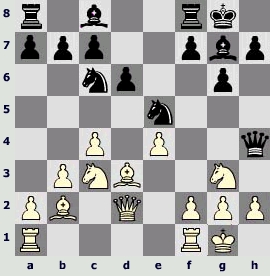
12. . . . f7-f5!
It`s the beginning of the dangerous for the opponent pawns attack on the King side. It was not easy to choose exactly that move, because Black had at the disposal another tactical ways of attacking.
In the variant 12...Ґh6? 13.f4! ¤g4 14.h3 Ј:g3 15.hg White recaptures the initiative in view of the danger of 16.¤d5. For example, 15...Ґ:g4 [15...¤b4 16.Ґe2 Ґ:g4 17.Ґ:g4 Ј:g4 18.¤b5] 16.¤d5 Ґg7 17.Ґ:g7 ў:g7 18.¤:c7І (Dvoretsky).
12...¤g4?! 13.h3 ¤:f2 is tempting [13...¤ge5 14.Ґe2 ¤d4 15.¤d5І]. It`sabsolutelybadly 14.ў:f2? Ґd4+ 15.ўf3 ¤e5+; in case of 14.¦:f2 Ј:g3µ White loses a pawn, and the capture at f2 by the Queen leads to its loss.
Nevertheless White plays 14.Ј:f2!! Ґd4 15.Ј:d4 ¤:d4 16.¤d5!.
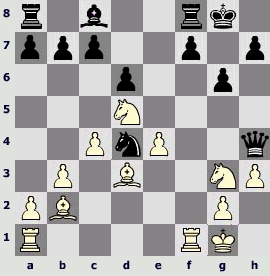
"Here usual material correlations recede into the background and specific peculiarities of a position come to the front. In spite of the considerable advantage of Black, White by no means has a worse position, and psychologically unexpected turning-point is favourable for him" (Nezhmetdinov).
16...¤e6? 17.Ґf6! loses immediately.
At 16...¤c6 Nezhmetdinov points out the variant 17.¦f4 Јd8 [17...Јg5 18.h4] 18.Ґf6 Јd7 19.Ґe2 h5 20.¤:h5! gh 21.¦h4 ўh7 22.Ґ:h5ќ.
After 16...Ј:g3 17.¤e7+ ўg7 18.Ґ:d4+ f6 19.¦f3 Јg5 20.¤d5 c5 21.Ґb2 with subsequent ¦af1 White in Nezhmetdinov`s opinion still has a strong attack. Let`s continue the variant: 21...Ґe6 22.¤c7 [22.¦af1? Ґ:d5; 22.¤:f6 ¦:f6 23.¦af1 ¦af8 with equality] 22...Јd2 23.¦b1 ¦ae8 24.¤:e8+ ¦:e8 25.Ґ:f6+ ўg8 26.¦b2 – there arises an unclear position.
Nezhmetdinov considered 16...c5!? to be the best defense, and after 17.¤e2 ¤:e2+ 18.Ґ:e2 f5 19.¦f4 Јh6 20.¦af1 continued the variant like this: 20...g5 21.¦:f5! Ґ:f5? [21...¦:f5› is necessary (Dvoretsky)] 22.¤e7+ ўf7 23.¤:f5ќ. Emms noted that instead of 20...g5?! it`s far better to play 20...Ґe6!, and only if 21.¤c7, then 21...g5!.
An interesting way of defense that was suggested by Joel Lautier should also be mentioned: 16...f5!? 17.Ґ:d4 [17.¤e7+ ўf7is useless] 17...Ј:g3. The variants seem to be favourable for Black. For example: 18.¦f3 Јh4 19.¤:c7 [19.¦af1 ¦f7] 19...fe 20.¦:f8+ ў:f8 21.Ґc2 ¦b8 22.Ґ:a7 e3! 23.¦f1+ ўg8 24.Ґ:e3 Ґ:h3 25.¤d5 ¦f8µ (Dvoretsky).
Thus, objectively Black could allow a sacrifice of the Queen for two light pieces, in the variants 16...c5!? and 16...f5!? he managed to defend himself from the direct attack and to retain the material advantage. But it`s far easier for White to play in such a situation, that`s why Nezhmetdinov had made the correct choice: he avoided a difficult defense and kept the initiative.
13.f2-f3!
"It`s the beginning of a profound plan of defense" (Nezhmetdinov). 13.f4? ¤g4! 14.h3 Ґd4+ 15.ўh1 Ј:g3 16.hg Јh4# was losing. The opening of the file "g" after 13.ef gf was into the hands of Black.
13. . . . Ґg7-h6!
It`s not an obvious development of the attack. Black intends to make the next move f5-f4, then why doesn`t he leave the Bishop at g7, where it`s more active? The point is that he is planning g6-g5-g4 and sees about in advance that the pawn f4 is defended securely.
14.£d2-d1 f5-f4
15.¤g3-e2 g6-g5
16.¤c3-d5 g5-g4
17.g2-g3
The continuation of the defensive plan, started by the 13th move of White. 17.¤:c7? g3! 18.h3 Ґ:h3 19.gh Ј:h3 was losing immediately.
17. . . . f4:g3
An immediate 17...Јh3!? deserved attention. In the opinion of Efim Geller after 18.¤e:f4 Ґ:f4 19.¤:f4 ¦:f4 20.gf g3 21.hg Ј:g3+ 22.ўh1 Black has only a perpetual check. Actually, as Emms has noted, he can get a great advantage, playing 22...Јh4+ 23.ўg1 Ґh3! 24.Јe1 [24.¦f2 Јg3+ 25.ўh1 Ј:f2 26.Јg1+ Ґg2+ 27.Ј:g2+ Ј:g2+ 28.ў:g2 ¤:d3°] 24...Ј:e1 25.¦f:e1 ¤:d3.
18.h2:g3 £h4-h3
19.f3-f4
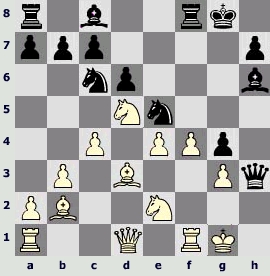
19. . . . ¥c8-e6!
"Only in such almost a paradoxical way, which indirectly provides a key position of the Knight е5 (20.fe Ґ:d5 иҐe3+) and prepares a blow at f4 (¦f7, ¦af8, ¦:f4!), it`s possible to revive the damping initiative" (Nezhmetdinov).
In case of stereotyped 19...¤f3+? 20.ўf2 Јh2+ 21.ўe3 the advantage passed to White in view of the threats 22.¦h1 and 22.¤:c7.
20.Ґd3-c2?
In the opinion of Nezhmetdinov 20.Ґb1 is more accurate, in order to keep the Bishop safe in case of intrusion of the black Knight at b4. However after 20...Ґ:d5 Black holds the advantage at any capture of the Knight:
A) 21.ed ¤f3+ 22.¢f2 £h2+ 23.¢e3 ¦ae8+ 24.¥e4 ¦:e4+! 25.¢:e4 ¦e8+ 26.¢d3 ¤b4+ 27.¢c3 a5°;
B) To 21.cd Nezhmetdinov examines 21...¤e7 22.ўf2 ¦:f4+!! 23.gf [23.¤:f4 Јh2+] 23...¤7g6!, proving that in every variant Black holds the strong attack. Emms noted that White can defend himself better: 22.Ґ:e5 de 23.¦f2 Ґ:f4! 24.gf ef, though this position is unsafe as well. In his turn, Black can play stronger 21...¦:f4! 22.gf g3 23.¤:g3 Ј:g3+ 24.ўh1 Јh3+ 25.ўg1 ўh8 with decisive threats (Dvoretsky);
C) 21.Ј:d5+ ¦f7 22.Ґc3 ¦e8 23.Ґc2 ¤f3+ 24.ўf2
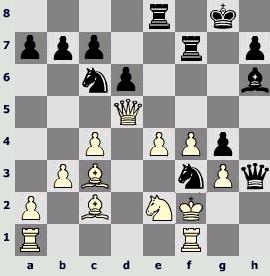
Nezhmetdinov continued the variant like this: 24...¤e7 25.Јe6 [25.¦h1 ¤:d5 26.¦:h3 gh 27.cd ¤g5 28.ўe3 ¤:e4 29.Ґ:e4 ¦fe7°] 25...Јh2+ 26.ўe3 ¤f5+! 27.ef ¦:e6+ 28.fe ¦e7 29.Ґf5 Јh5µ. He overlooked a not difficult defense: 25.Ј:f7+! ў:f7 26.¦h1 ¤h2 27.ўg1 ¤f3+ 28.ўf2 with equality. However it is avoided by changing the moves: 24...Јh2+! (instead of 24...¤e7?) 25.ўe3 ¤e7 26.Јe6 ¤f5+!, and further according to the variant of Nezhmetdinov (Dvoretsky).
In case of 20.¤:c7 it`s need to be decided which piece is to attack f4. Emms considers 20...¦:f4, but his analysis is not exact. He considers 21.¤:f4 Ј:g3+ 22.ўh1 Ґ:f4 23.¦:f4 ¤:d3 24.¤:e6 with unclear playing to be correct, but simple 23...Ј:f4! (instead of 23...¤:d3?) leads to Black`s win. And in the variant 21.gf! g3 22.¤:g3 Ј:g3+ 23.ўh1 Јh3+ 24.ўg1 Ґg4! White plays not 25.Јc2? ¦f8!° (Emms), but 25.Ґe2! with equality (Dvoretsky).
That`s why Black should respect the recommendation of Nezhmetdinov: 20...Ґ:f4! 21.¦:f4 [21.¤:f4? £:g3+ 22.¤g2 ¦:f1+ 23.¥:f1 ¤f3+ °; 21.gf? g3!°] 21...¦:f4 22.¤:a8 [22.¤:e6 ¦f3°] 22...¦f3 [22...¦f8 23.¤c7 ¤f3+ 24.¢f2 ¤fd4+!? 25.¢e3 is weaker (25.¢g1? ¤:e2+ 26.£:e2 £:g3+ 27.£g2 £e3+ 28.¢h1 ¦f3°) 25...¦f3+ 26.¢d2 £h6+ 27.¢c3› (Emms)] 23.¥c2 ¦:g3+ [23...¤:c4 24.bc ¦:g3+ 25.¤:g3 £:g3+ 26.¢h1= (Emms)].
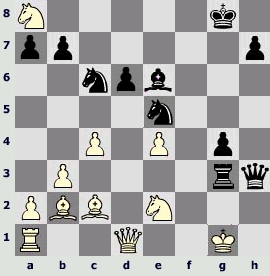
Here Nezhmetdinov stopped analyzing having estimated the position of Black as the won one. Emms didn`t agree to his estimation and proceeded with the variant: 24.¤:g3 Ј:g3+ 25.ўf1 ¤:c4 26.Ґc1! Јh3+ 27.ўg1 g3 [rejecting 27...Јg3+ with perpetual check Black tries to achieve something better] 28.Јe2 ¤d4 29.Јg2 Ј:g2+ 30.ў:g2 ¤:c2 31.¦b1, and by now White has an advantage. In fact the estimation of Nezhmetdinov is correct – Black just shouldn`t exchange Queens: 29...¤f3+! 30.ўf1 [or 30.Ј:f3 Јh2+ 31.ўf1 ¤e5°] 30...Јh4!, and White will hardly save himself.
Perhaps the best defense is 20.Ґc1!?.
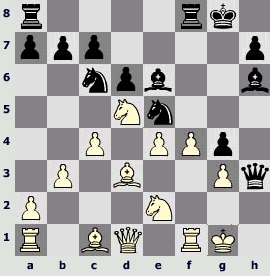
Nezhmetdinov gives two exclamation marks to the response 20...¤d4, and perhaps for nothing. Because after 21.¤:d4 Ј:g3+ 22.ўh1 Black is either to yield to perpetual check (22...Јh3+ 23.ўg1 Јg3+), or to play the variant 22...Ґ:d5 23.fe Јh3+ 24.ўg1 g3 25.¦:f8+ ¦:f8 26.¤f3 g2 27.Ґe2 Ґ:e4 28.Ґ:h6, which also doesn't bode anything better than a draw. That's why Emms suggests 20...¤f3+! (instead of 20...¤d4) 21.ўf2 Јh2+ 22.ўe3 Ґg7 23.¦h1 Јg2 24.e5 Ґf5, and the King of White is still in danger.
20. . . . ¦f8-f7
21.¢g1-f2 £h3-h2+
22.¢f2-e3 ¥e6:d5
23.c4:d5
To 23.ed 23...¦e8!° is strong, but, as Emms noted, White should have tried 23.Ј:d5!?.
23. . . . ¤c6-b4
24.¦f1-h1

Both chess players were striving for this position. Black has under the blow not only the Queen, but also the Bishop, which is hiding behind its back. However a brilliant blow, which was prepared by Nezhmetdinov in advance, demonstrates the accuracy of his strategy.
24. . . . ¦f7:f4!!
25.¦h1:h2
In case of 25.¤:f4 both 25...¤:c2+ and 25...Ј:g3+ are decisive. 25.Ґ:e5 ¦f3+ is of no use, and if 25.gf, then 25...Ґ:f4+ 26.¤:f4 [26.ўd4 Јf2+ 27.ўc3 Јc5#] 26...¤:c2+.
25. . . . ¦f4-f3+
26.¢e3-d4
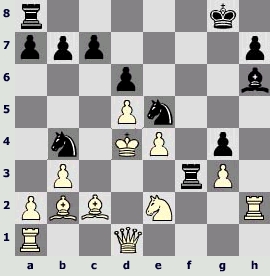
26. . . . ¥h6-g7!!
It's an excellent move, which sets up two threats: а) 27...b5! with subsequent 28...¤ec6#; б) 27...c5+ 28.dc bc and 29...c5#. White doesn't have an adequate defense.
Nezhmetdinov declined an immediate 26...c5+!? because of 27.dc bc 28.Ґd3! ¤e:d3 29.¦:h6! ¤:b2 30.¦:d6 ¤:d1 31.¦:d1 with unclear position. However Black can play stronger in this variant 27...b5! (instead of 27...bc) 28.Ґd3 (it's the only protection against a checkmate) 28...¤e:c6+ 29.ўc3 Ґg7+ 30.ўd2 ¦:d3+ 31.ўe1 ¦:d1+ 32.¦:d1 Ґ:b2, and Black is to win (Dvoretsky).
27.a2-a4
White parries the first of two threats (27...b5), but Black carries out the second one. The detailed analysis made by Nezhmetdinov proves winning in all the rest variants.
27.¤f4 b5! 28.£:f3 ¤:f3+ 29.¢e3 ¥:b2°;
27.¤g1 ¦:g3! 28.¤e2 ¦f3 29.¤g1 ¤ed3+ 30.¢c4 [30.e5 ¥:e5+ 31.¢c4 ¦f4+! 32.¥d4 ¦:d4+ 33.¢c3 ¤:d5+ 34.¢d2 ¥f4+ 35.¢e2 ¦e8+ 36.¢f1 ¤e3+ °] 30...¤:b2+ 31.¢:b4 ¥c3+ 32.¢a3 b5!! 33.£d4!? [33.b4 a5! 34.ba ¤c4+ 35.¢b3 ¤:a5+ 36.¢a3 ¤c4+ 37.¢b3 ¦a3#] 33...¥:d4 34.¤:f3 ¥c3! 35.b4 ¤c4+ 36.¢b3 ¥:a1 37.¤g5 g3!°;
27.¥d3 ¤e:d3+ 28.¢c4 ¤:b2+ 29.¢:b4 ¤:d1 30.¦:d1 ¦e8 31.¦dh1 ¦:e4+ 32.¢a5 [32.¢a3 b5°] 32...¦fe3° [or 32...¥c3+ 33.¤:c3 ¦:c3° (Dvoretsky)];
27.¦f2 ¦:f2 [no less stronger 27...c5+ 28.dc ¤ed3+ 29.¢c4 b5+ 30.¢:b5 ¦b8+ 31.¢a4 (31.¢a5 ¤:c6+ 32.¢a4 ¦b4+ 33.¢a3 ¥:b2#) 31...¤:b2+ 32.¢a3 ¤:d1 33.¦:f3 ¤:c2+ 34.¢a4 ¤b2+ 35.¢a5 gf° (Emms)] 28.¢e3 [28.¥c3 ¦f3! 29.¥:b4 b5!°; 28.¥a3 ¦f3! 29.¤g1 ¤ec6+ 30.¢c4 ¦c3°; 28.¥c1 ¦f3 29.¥e3 ¤ed3+ °] 28...¦f3+ 29.¢d2 ¥h6+ 30.¤f4 [30.¢e1 ¤bd3+] 30...¦:g3°;
27.¤c3 ¦:g3 [Emms points another way to the aim: 27...¤ed3+ 28.e5 (28.¢c4 ¤:b2+ 29.¢:b4 ¥:c3+ 30.¢a3 b5 31.b4 a5°) 28...¥:e5+ 29.¢c4 ¤:b2+ 30.¢:b4 ¥:c3+ 31.¢a3 ¤:d1 32.¦:d1 ¦:g3 33.¦:h7 ¦g2°]. Now Black is planning 28...a6!!, and next either 29...¤ec6+ 30.ўc4 ¦:c3+! 31.Ґc3 b5#, or (for example in response to 29.a4): 29...c5+ 30.dc bc and, 31...c5#. Such variants arise:
А) 28.¤b5 a6!! (the danger of 29...¤ec6+ 30.¢c4 ab+ 31.¢:b5 ¦a5+ 32.¢c4 ¦c5#) 29.a4 [29.¤:c7 b5! 30.¤:b5 ab°] 29...ab 30.ab, and now 30...¦f8!° (Dvoretsky), but not 30...¤ed3+ 31.e5 [31.ўc4? ¤:b2+ 32.ў:b4 Ґc3#] 31...Ґ:e5+ 32.ўe4 ¦f8 (in the opinion of Nezhmetdinov Black wins in connection with threats 33...¤c5# and 33...¦f4#] 33.Ґ:e5! with advantage of White;
B) 28.¤e2 ¦f3 29.¤c3 ¤ed3+ 30.¢c4 ¤:b2+ 31.¢:b4 ¥:c3°;
C) 28.¦h5 ¤bd3! (the danger of 29...¤c6+ 30.¢c4 ¤:b2+ 31.¢b5 a6#) 29.¥:d3 [29.¦b1 ¤c6+ 30.¢c4 ¤:b2+ 31.¦:b2 ¦:c3+ 32.¢b5 ¦c5+ 33.¢a4 ¦a5#; 29.¥a3 b5! 30.¤:b5 ¤c6+ 31.¢c4 ¤a5#; 29.¥c1 b5! 30.¥e3 ¤b2!!°; 29.£c1 b5! 30.£e3 ¤b4!! 31.¤:b5 ¤:c2+ 32.¢c3 ¤:e3°] 29...¤:d3+ 30.e5 [30.¢c4 ¤:b2+ 31.¢b4 ¥:c3+ и 32...¤d1°] 30...de+ 31.¢c4 [31.¢e4 ¦f8!; 31.¦:e5 ¥:e5+ 32.¢e4 ¥:c3!] 31...¤:b2+ 32.¢b4 ¥f8+ °.
27. . . . c7-c5+
28.d5:c6 b7:c6
29.Ґc2-d3
There is no other protection against the checkmate.
29. . . . ¤e5:d3+
30.¢d4-c4
30.e5 ¥:e5+ 31.¢c4 d5#.
30. . . . d6-d5+!
31.e4:d5 c6:d5+
32.¢c4-b5 ¦a8-b8+
33.¢b5-a5 ¤b4-c6+
White resigned.
